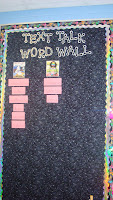I went to a departmentalized Grade 2 English Language Arts classroom while the students were at resource and the teacher was out of the room. What I learned is that you can find out a lot about a classroom by simply reading the room.

What I learned, in this particular classroom, is that there is an established Skills Block. Students have been learning high frequency spelling words and the language skills like nouns, verbs, and adjectives. Students have also reviewed punctuation. There is evidence of multiple presentation styles including embedded strategies in songs. In writing, students are working on Personal Narratives. They've learned about the story elements including how to make their seed idea grow, and how to sprinkle details throughout their writing. They've also learned how to write leads that engage the reader. In addition, students have learned editing skills to make their writing stronger. Students' writing samples are proudly displayed in the classroom and on the bulletin board in the hallway. And, they student has work in their writing journals tucked neatly in their desks.
Furthermore, it is very apparent that the teacher has provided an environment to grow an avid reader. There is an ample classroom library which includes a leveled library, genre library, and guided reading library. There are comfy reading nooks for students to relax and enjoy a good book. They've learned the habits of what good readers do, and have learned what a good listener looks like. The teacher has taught them the pro
 cedures for listening to a read aloud. Completed read alouds are displayed on a chart. The students are learning to identify the main idea in a passage or in their independent
cedures for listening to a read aloud. Completed read alouds are displayed on a chart. The students are learning to identify the main idea in a passage or in their independent  reading book, and are keeping book logs of the books they've read. I also noticed that the teacher has assessed students using the DRA 2, because on one table in the room the teacher has sticky notes with student's names listed on a pile of Guided Reading books. So, I assume her small groups will get started soon. The room is print rich. Vocabulary words, like contagious and distraction, are displayed on the word wall next to the Text Talk read aloud stories. In addition, students have an individual book bag with books that are on their reading levels.
reading book, and are keeping book logs of the books they've read. I also noticed that the teacher has assessed students using the DRA 2, because on one table in the room the teacher has sticky notes with student's names listed on a pile of Guided Reading books. So, I assume her small groups will get started soon. The room is print rich. Vocabulary words, like contagious and distraction, are displayed on the word wall next to the Text Talk read aloud stories. In addition, students have an individual book bag with books that are on their reading levels.I'm sure you would agree that reading the room is a valuable tool from the coaching perspective. You don't need long to get a snapshot of teaching and learning. And, it can be a valuable learning tool for other teachers. Visiting a colleague's classroom can inspire an "ahhh haaa" moment that may give you a fresh new idea.


This does sound like a rich learning environment. I'm a children's book author who has spent many years "reading the room" as a substitute teacher.
ReplyDeleteAs a coach, I appreciate how you share your process here. What a refreshing way to approach assessment---do you carry a camera to document? Thanks for sharing---
ReplyDeleteYou really pointed out how much you can learn from reading a room. Although you mostly identified ELA artifacts and their connected teachings, math classroom walls also can also be pretty precise indicators of what's been going on.
ReplyDeleteI need to do more large scale postings for my kids. I think that I have been busy thinking of "class book" and blog documentation at the expense of the "posterization" of math concepts. I am pretty sure that kids would find large areas of strategy work easier to use than either of the two previously mentioned endeavors.
I will start with a large poster entitled, "Why We Love Mrs. Shall: Let Us Count The Ways!".
Peace,
T-Cubed
A good learning environmentis essential for a successful classroom.The classroom has to healthy in all aspects to put the classmates to comfort.A wonderful site delivers the importance of the classroom.
ReplyDelete